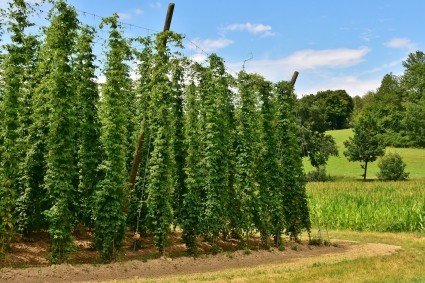How to recognize it ?
The hop, which has the Latin name of Humulus lupulus, is also called northern vine, native sarsaparilla, and golden hop.

It is a deciduous climber and perennial by its rhizome. Its long stems can grow to nearly 10 meters (30 inches) and curl rapidly, clockwise.
How to grow and harvest it ?
Hops have been grown for centuries and industrially to produce beer. Its leaves look a bit like vine leaves. The bloom takes place in summer preferably with an exposure in the sun or in half-shade. The flowers of the male plants are small panicles whereas the flowers of the female plants are in the shape of cones (strobiles) of yellow green color covered with hairs secreting a yellow powdery substance : the lupulin (or lupuline). The strobiles are harvested towards the end of the summer.

- Transplanting : in pot.
- Planting : in spring after the frosts.
- Sowing in the open ground : at the end of autumn, germination the following spring.
- Emergence : between 15 days and 2 months.
- Distance between plants : 1 meter (3 inches).
- Soil : humid, light, drained.
- Composting requirements : at planting and every spring.
- Mulching : in summer and winter.
- Water requirements : regular except in winter.
- Possible culture in pot : yes, to make climb.
Medicinal virtues
The hop is indicated :
- in the nervous states, of anguish, neurosis and the depressive states.
- in period of premenopause and menopause for its action on hot flashes and on osteoporosis.
- to facilitate the falling asleep and the maintenance of the sleep, (often in association with the valerian).
- on digestive disorders and gastric and intestinal spasms.
Be careful, hops should not be used in people at risk of hormone-dependent cancers! Indeed, it will mimic the action of estrogen hormones with a certain carcinogenic risk.
Updated on 09 December 2022 at 16:22







